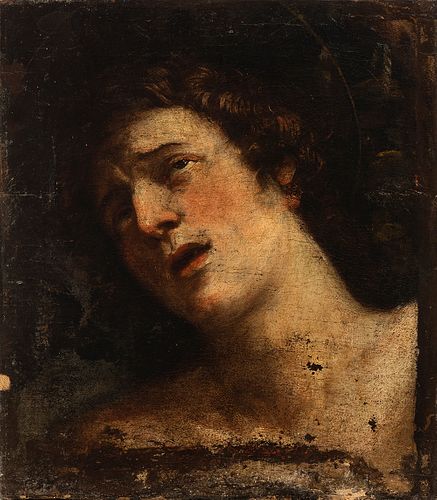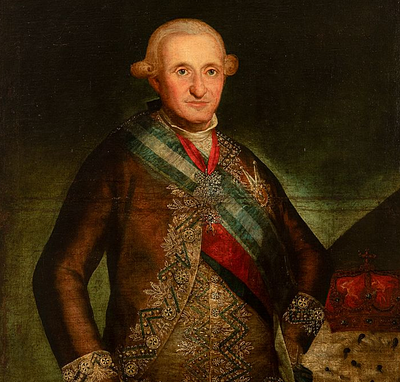Circle of JERÓNIMO JACINTO ESPINOSA (Cocentaina, Alicante, 1600-Valencia, 1667). "Bust of Saint Sebastian". Oil on canvas. Relined.
Lot 3
About Seller
Setdart Auction House
Carrer Aragó 346
Barcelona
Spain
Setdart Subastas was born in 2004 and is currently the first online art auction in Spain with solidity, prestige and reliability guaranteed by our more than 60,000 users. Setdart has a young, dynamic and enterprising team ready to successfully manage the purchase and sale of art works through custom...Read more
Estimate:
EUR€1,500 - EUR€2,000
$1,612.90 - $2,150.54
Absentee vs Live bid
Two ways to bid:
- Leave a max absentee bid and the platform will bid on your behalf up to your maximum bid during the live auction.
- Bid live during the auction and your bids will be submitted real-time to the auctioneer.
Bid Increments
| Price | Bid Increment |
|---|---|
| EUR€0 | EUR€10 |
| EUR€200 | EUR€25 |
| EUR€500 | EUR€50 |
| EUR€1,000 | EUR€100 |
| EUR€3,000 | EUR€200 |
| EUR€5,000 | EUR€500 |
| EUR€10,000 | EUR€1,000 |
| EUR€20,000 | EUR€2,000 |
| EUR€50,000 | EUR€5,000 |
About Auction
By Setdart Auction House
Sep 22, 2021
Set Reminder
2021-09-22 09:30:00
2021-09-22 09:30:00
America/New_York
Bidsquare
Bidsquare : 22nd September - ARAS JÁUREGUI Private Collection - Old Masters, 19th & 20th Century
https://www.bidsquare.com/auctions/setdart-auction-house/22nd-september---aras-j-uregui-private-collection---old-masters-19th-20th-century-7427
ARAS JÁUREGUI Private Collection - Old Masters, 19th & 20th Century Setdart Auction House sofia@setdart.com
ARAS JÁUREGUI Private Collection - Old Masters, 19th & 20th Century Setdart Auction House sofia@setdart.com
- Lot Description
Circle of JERÓNIMO JACINTO ESPINOSA (Cocentaina, Alicante, 1600-Valencia, 1667). "Bust of Saint Sebastian". Oil on canvas. Relined. It presents important dalos and restorations. Measurements: 42 x 37 cm. The dramatic expression of this portrait, added to the youth and the anatomy of the protagonist, invite the spectator to think in the representation of Saint Sebastian. Born in Gaul and raised in Milan, Sebastian was a centurion of the first cohort in the time of the Emperor Diocletian (late 3rd - early 4th century). Denounced because he exhorted his friends Mark and Marcellinus to remain steadfast in their faith, by order of the emperor he was tied to a post in the centre of the Field of Mars, and served as a live target for the archers who shot him. But he did not die for it. The widow Irene, who wanted to raise his body for burial, noticed that he was still breathing, bandaged his wounds and saved his life. After he was cured, he reappeared before Diocletian to reproach him for his cruelty towards the Christians. He was then scourged, beaten to death in the circus and his corpse was thrown into the Maximian sewer. Shortly afterwards, Saint Sebastian appeared to Saint Lucila in her sleep to reveal to her the location of his remains, and asked her to bury him in the catacombs. Due to the aesthetic characteristics of the work, it can be related to the artistic circle of Jerónimo Jacinto Espinosa, who portrayed the saints on numerous occasions, most notably Saint John in the Museo del Prado, whose face largely recalls the present work. Espinosa signed his first major work, The Miracle of the Christ of the Rescue, in 1622-23. In this canvas he already showed a fully mature style, which soon earned him new commissions from various Valencian convents. His masterly portrait of the Dominican Jerónimo Mos (1628) also dates from this period. Espinosa also worked for the local nobility, although many of the works he executed before 1640 have been lost. In the following years, and especially in the last decade of his life, he produced his most notable works, and worked for the cathedral, the University and the city of Valencia itself. It should also be noted that we have preserved some drawings by his hand, which give us a better understanding of his system of working. These are studies from life, which are essential to achieve the realism of his painting. His work on canvas was fast, with Venetian-style brushstrokes, glazes and fluid paste. As a result, he achieved a brilliance of colour praised by his contemporaries. Espinosa's works are currently housed in the Prado Museum, the Valencia Fine Arts Museum, the University of Valencia, the National Art Museum of Catalonia, the City of Valencia Museum and other collections, both public and private, as well as in various religious centres in the Region of Valencia.
- Shipping Info
-
In-house shipping available. Please inquire at admin@setdart.com.
-
- Buyer's Premium



 EUR
EUR CAD
CAD AUD
AUD GBP
GBP MXN
MXN HKD
HKD CNY
CNY MYR
MYR SEK
SEK SGD
SGD CHF
CHF THB
THB














